Mythology or Ithasaa are just labels, and some might find it controversial if I attach Jyotish to a similar placeholder. Jyotish entwines mythological fables in its narration and allows exploration of the human condition.
One such fable rises from the highly celebrated ‘Ramayana.’ The prime antagonist of the epic, Ravan.
Ravan is a study of contradictions, the king of Asuras, the master of the three realms, yet, a slave to his ego.
He was not always Ravan; he was born Poulastya (grandchild of Maharishi Pulastya). He mastered the ten sacred texts through rigorous penance and earned the name ‘Dashashan’ (ten-headed). However, Dashashan’s ego never left him. In one such rush of ego, Dashashan audaciously attempted to lift Kailas Parvat (Mountain) along with the meditating Lord Shiva on top. Shiva, who has the power to destroy the universe, just flexed the thumb of his foot. This pressed the mountain down, crushing Dashashan underneath. Dashashan’s body gave out a loud scream in agony, a roar that trembled every corner of the universe. A loud roaring scream is defined as ‘Ravan.’
Hence, Dashashan became known as Ravan.
To escape the crushing Kailas Parvat, Ravan had to appease Lord Shiva. To earn Shiva’s forgiveness, Ravan composed the ‘Shiv-Tandav stotra.’ Ravan created a 16 syllable per line Sanskrit poetry. An unparalleled feat. Poetry with alternating 16 short syllables, long syllables, and apt use of alliteration and onomatopoeia. Ravan created a rumbling ravaging effect to mimic the cosmos’ formation, the primordial Tandav dance of Shiv.
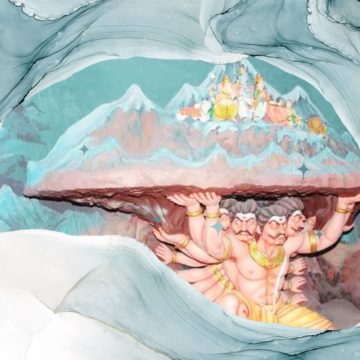
And remember, Ravan composed such a marvelous gem while bearing a load of an entire mountain on his shoulders. Such was his mastery.
This story gives us a glimpse of Ravan’s high might and intellect. The master of the Vedas, all the Vedangas, all Shastras and Kalas. How could he not have mastered the Jyotish Shastras!
The testament to Ravan’s mastery is the ‘Ravan Samhita,’ a work regarded as the most potent text on Jyotish to date.
Since we are talking about Jyotish, let’s explore a tale that intertwines Ravan and Jyotish Vidya.
Ravan’s enemies, the Devas, conspired to have the ‘navagrahas’ occupy poor positions at the time of the birth of Ravan’s son. Ravan, the master Jyotish understood the implications of this. He kidnapped the navagrahas and made them follow his will. Ravan placed them in impeccable order at his son’s birth. Giving his son the destiny to become an all-powerful and universal ruler of the realms.
After that, each Graha was tied face-down to each ascending step towards Ravan’s throne. Shani’s head faced the ignominy of becoming the footrest for the seated king.
The signs were ominous for the Devas. Ravan had control over everything. He had already captured the realms, and with the Grahas forced to obey his orders, Ravan now owned the future as well. Under desperation, the Devas approached ‘Narad Muni’ for some relief. Narad Muni decided to try and traveled to Ravan’s court. In his typical style, Narad Muni began by massaging Ravan’s ego and proceeded to provoke him.
Narad Muni proclaimed it is far more glorious to walk over your enemies while staring into their eyes.
Immediately Ravan ordered all the Grahas to move from their upside-down position to a face-up position.
The Grahas were still tied, unable to move or cause much harm. They were still trampled under Ravan’s will. However, by lying face up, it freed Shani’s gaze

Shani’s gaze works in silence. It slowly creeps up on a person. The learned king, who knew the Vedas, who knew the importance of respect for women, could not apply his knowledge to his actions. Ravan abducted Sita. Ravan could have turned things around on several occasions in his war with Rama. But, his arrogance prevented him from acting on sound advice.
All that Ravan held dear was withering right in front of his eyes but blinded by arrogance, he could see nothing. That’s Shani modus operandi. When Shani acts, he takes the responsibility to shatter all that is fake, unreal, and false, to empty you, make you devoid of everything so that all that’s left is ‘You.’ Shani makes one see the truth in the most challenging way; by destroying all the Maya that one holds dear.
Ravan’s destruction raises many philosophical questions. What is ego? What is arrogance?
Myths, Itihaas, Vedas, Upanishads, Jyotish, what are these? Some take them at face value, either as stories to be enthralled by or as prescriptions on life. Can we slot the story of Ravan’s tryst with Jyotish Grahas into such simple formulations? Or, Can we aspire to explore the layers and layers of philosophical inquiries underlying them?
This is a choice you will have to make.


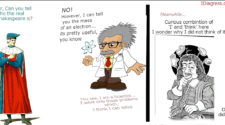
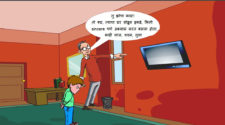




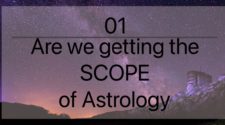


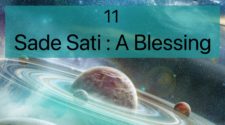

[…] Dashagriva […]
[…] ego is a big example here. His fall after mastering everything is a cautionary tale in itself (Read Ravana’s article here.)In recent times, D. Trump is someone who come to mind, rising to the highest echelons, and now he […]